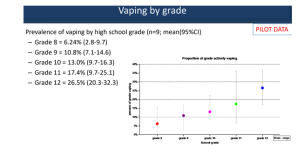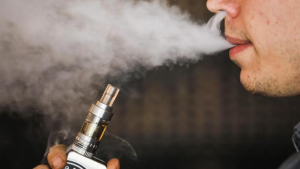A research survey has revealed that about 23% of learners can’t go through a day of school without vaping meanwhile 6.24% of Grade 8 learners are already using e-cigarettes. The health risks associated with the use of e-cigarettes and the water pipe dominated talks at a webinar hosted by the National Department of Health this week. These talks are on the backdrop of the Control of Tobacco Products and Electronic Delivery Systems Bill which was recently approved by cabinet and submitted to parliament by the Ministry of Health.
Young people are at the centre of what some public health experts term as “tobacco industry tactics”. The glamorisation and normalisation of vape-use or e-cigarettes in an effort to attract the youth has seen an increase in the use and subsequent dependence on these devices among school learners.
High rates of vaping and addiction among learners in schools
Speaking at the webinar, Professor Richard van Zyl-Smit, Pulmonologist in the Division of Pulmonology Department of Medicine at the University of Cape Town and the Groote Schuur Hospital says the adolescent brain is sensitive to nicotine. He further elaborates that the developing brain of a young learner can easily become addicted to nicotine even at low levels of exposure. This can cause impaired cognitive function and behavioural problems associated with depression and panic disorders in both the short and long term.
Although not representative of the whole country, he provides analysis of the outcomes of the small-scale research survey that reveals alarmingly high levels of vape-use and dependency among teenagers as young as grade 8 learners. The highest addiction rates are observed in grade 12 learners.

The surge in young people using e-cigarettes and the vast health implications caused by continual use as a result of addiction is a major cause for concern “In terms of pure addiction this is somewhat worrying”, says Professor van Zyl-Smit. He further explained that the research study shows just how easily addiction can occur in a young person in particular “for those of you familiar with tobacco addiction and the Fagerstrom test, usage within the first 5 minutes to an hour is strongly associated with nicotine addiction and development of withdrawal and here we have roughly 30% using within the first 5 minutes”.
The addiction rate will require a multi-layered approach when tackling the issue of why young people are vaping. Professor van Zyl-Smit’s emphasis is that program development that will address both the behavioural intervention and nicotine withdrawal problem is required moving forward.
Many learners are finding it hard to keep up with their addiction to vaping “[23%] can’t go through a school day without vaping which is why the school principals are concerned and are obviously calling on me to do these talks says Professor van Zyl-Smit. “The potential evidence of nicotine withdrawal symptoms is that they [the learners] get angry or anxious if they can’t vape” he adds.

So why are young people vaping? Stress and anxiety; vaping helps us cope say learners
There have been a number of factors established as part of the key findings of the research survey on why teenagers are vaping. While some learners say they are simply curious, others maintain that the fruit flavours of e-cigarettes are appealing and intriguing.
However, a significant number of learners have chosen to start toying with these electronic nicotine delivery systems as a coping mechanism due to mounting stress and anxiety-related factors. These remain the main and common reasons found across all the schools that formed part of the study in the answers provided by the majority of learners.
Tobacco industry targeting youth: glamorisation of vaping – a call for legislative intervention
Some public health experts are calling for government to tighten the belt on legislation in response to what has been described as the tobacco industry’s “normalisation strategy” of vape and e-cigarettes; which is said to be targeting the youth and women in particular.
Expanding on what exactly this means Professor Lekan Ayo-Yusuf, heading the School of Health Systems and Public Health at the University of Pretoria, is adamant that the tobacco industry is opportunistically playing on any ambiguity in the current legislation to confuse the general public and health officials regarding e-cigarettes and vaping.
Presenting at the webinar, Professor Ayo-Yusuf says the go-to tactics used by the tobacco industry to lure young users to new and existing e-cigarette products is entrenched in their messaging. “The tobacco industry confuses government and confuses the public saying no the FDA pronounced that some of the products were reduced risk. FDA pronounced them as reduced exposure, it’s not reduced risk. There is a big difference between reduced exposure and actual risk” explains Professor Ayo-Yusuf. In his presentation, he further expands on why the tobacco industry may be using this approach “the tobacco industry sees these products as a way to normalise themselves so that the public can see them as a ‘normal’ industry”.
Many people in the general population are of the misperception that vaping is not harmful; however, a common thread running throughout the webinar presentations clarifies that reduced exposure does not mean reduced risk. Vaping and e-cigarettes present their own risks and are still harmful. Nicotine has been found to increase the risk of many health complications thus contributing significantly to the total burden of disease in the country and globally.
Professor Ayo-Yusuf reaffirms the other research outcomes shared at the webinar based on findings of a study he has spearheaded. This study has not only found that there is indeed an increase in the number of young people using e-cigarettes; but it also found a dramatic increase in the sales of e-cigarette devices between 2021 -2022. This glaring observation was also noted when the ban on sales of cigarettes and related products was lifted during the period of the COVID-19 national lockdown. Looking particularly at ages 16 -34, the study reveals that the nicotine addiction rate in the country is rapidly increasing; “the total nicotine addiction population in South Africa among 16 years to 34 has actually increased over the last 10 years, therefore a need for regulation” says Professor Ayo-Yusuf.
While tracking the online sales of e-cigarettes, his research study shows that the high figures of sales captured at convenient stores (not vape stores) are as high as the numbers document across various online shopping platforms. While fruit flavoured vape sales are skyrocketing, menthol and mint follow closely. Professor Ayo-Yusuf says this is another channel the tobacco industry is using to gain access to the youth as a target market “so whatever regulation we do, we have to control online sales this is how youth get access, all they need is to get access to a credit card”.
In its current form, the legislative constrains of the Bill will see a tight squeeze placed on the vaping and e-cigarette industry; particularly advertising, sale and use in the country. With a possible push-back anticipated from the tobacco industry, the Bill may spark a continuous point of debate with many across the country.
The webinar is the third of a four-part series led by the National Department of Health regarding tobacco control in a quest to unpack the various aspects of the Bill.
The last and final webinar will be held on 16 November 2022.
Zandile Myeza is a SABC Specialist Researcher






